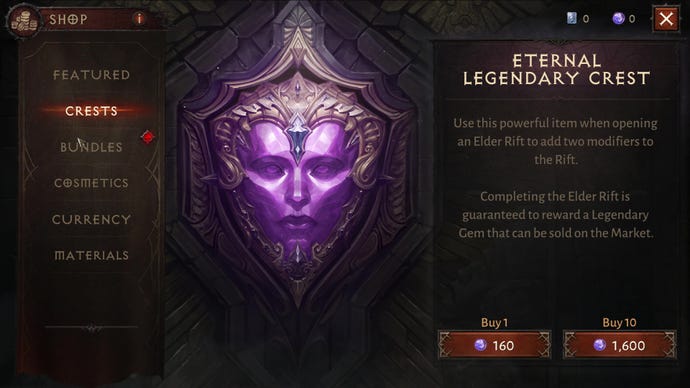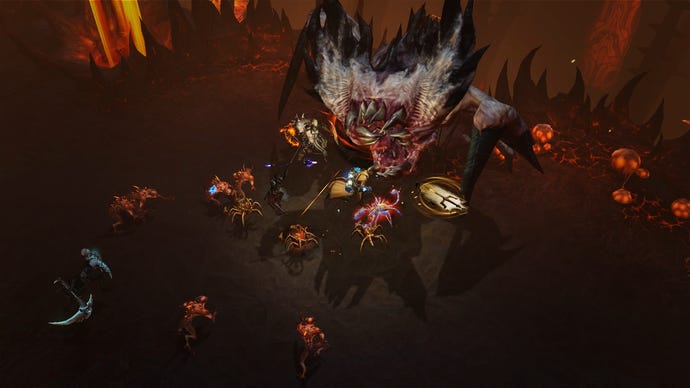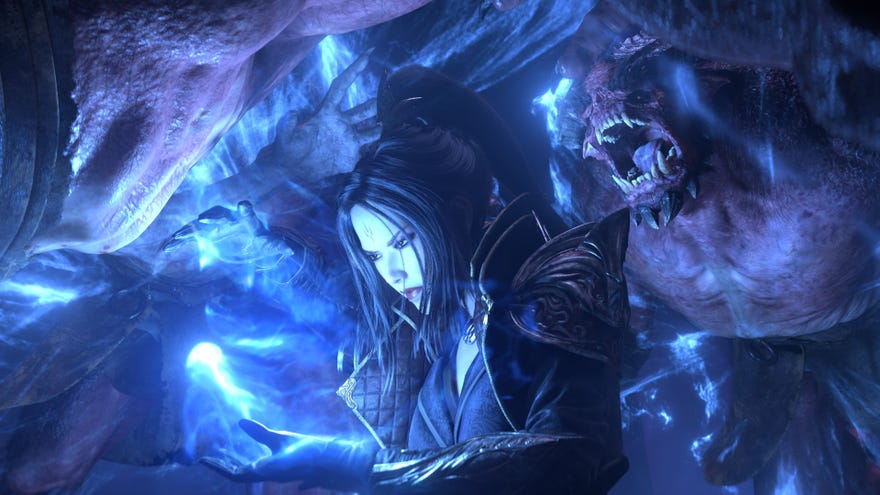How much does it cost to play Diablo Immortal?
The controversial monetisation model of Diablo Immortal explained
What is the real cost of Diablo Immortal, and is it in fact pay-to-win? Diablo Immortal is already infamous for its microtransaction monetisation model, which many players have pointed out are effectively loot boxes under a not-even-that-different name. You might have seen reports going around that it costs somewhere in the region of £88,000 / $110,000 to fully upgrade a character (and that an F2P player would need to grind for ten years to earn the same upgrade materials for free). This, coupled with the ongoing investigations into allegations of serious misconduct at publisher/developer studio Blizzard Entertainment, has quite understandably been enough to put many players off the game entirely.
However, it's clear that a lot of people are still playing Diablo Immortal, which, despite the various controversies surrounding its release, has become one of the most popular new games this June. And I can understand it. Finances are tight for a lot of people right now, and an F2P game that runs well on mobile devices and relatively low-end PCs can feel like a lifeline to gamers who can't currently afford to put a lot of money into their hobby. The fact that it's attached to an existing big-name franchise presumably helps boost that feeling of participation a lot too, which a cynic might say is the point.
The issue here, of course, is that Diablo Immortal (like many F2P games) is arguably not really free-to-play. I'm not interested in casting judgement on people who want to play a game that others have legitimate grievances with, but I was curious as to what the real cost of Diablo Immortal is. We already have that shocking £88,000 total figure, which I have no reason to dispute it would be possible to spend on this game. I've seen alternative calculations accounting for changes to drop rates in this beta version that now place the sum as "low" as £35,000 / $50,000 (in other words, just as ridiculously high when you think about it).
But what are you actually paying for in each individual microtransaction? The game isn't going to simply ask you for £88K in one go, after all. And at what point does an F2P player hit a wall in terms of their ability to participate in the game unless they start spending money?
I'm not here to tell you whether you should play Diablo Immortal from a moral standpoint, but I'm interested in informing you whether you even can play without dropping the cost of a nice house in Wales in the process, and what the real running costs would look like from a player's perspective.
What are you paying for in Diablo Immortal?
The premium currency in Diablo Immortal is called Eternal Orbs. Eternal Orbs are the only thing in the in-game store that comes with a real-world price tag, with the costs as follows:
- £0.89 / $0.99 for 60 Eternal Orbs
- £4.49 / $4.99 for 315 Eternal Orbs
- £8.99 / $9.99 for 630 Eternal Orbs
- £21.99 / $24.99 for 1,650 Eternal Orbs
- £44.99 / $49.99 for 3,450 Eternal Orbs
- £89.99 / $99.99 for 7,200 Eternal Orbs
The odd increases are down to the fact that you theoretically get bonus Eternal Orbs the more money you put in: buying at the second or third level claims to give you an "extra" 5%, 10% at the fourth level, 15% at the fifth, and 20% at the sixth and highest.

Eternal Orbs can then be spent in other tabs of the in-game store. A browse of the Materials tab shows that entry-level items go for a standard rate of 100 Eternal Orbs each, while on the Cosmetics tab a full costume costs 1,000 for a Standard outfit or 1,500 for a Collector's outfit. As is often the case in F2P games, then, we can see that paying 89p for the lowest-level currency top-up won't actually buy you anything from the in-game store on its own, and you'll be paying somewhere in the region of 20 quid to deck your character out in one of the premium outfits.
I suspect the real draw for many players, though, as well as the real point of contention, is the Crests tab. Here you can purchase Legendary Crests, which are essentially the loot boxes of Diablo Immortal. More on how they actually work below, but for now the thing to keep in mind is that it takes 160 Eternal Orbs to purchase one Legendary Crest, or you can buy 10 in a bundle for the not-at-all discounted price of 1,600 Eternal Orbs.

In real money, just to keep it in perspective, that's a minimum spend of £4.49 to buy not-quite-two Legendary Crests (purchase the second level currency top-up and you'll come up 5 Eternal Orbs short for the second Crest, which I'm sure is deliberate). Or it's £21.99 to purchase that 10-pack of Crests and leave you with 50 Eternal Orbs in leftover change (which to reiterate, is half the cost of the cheapest rock in the Materials tab).
Can you get Eternal Orbs for free?
Eternal Orbs are a properly premium currency in Diablo Immortal, meaning that there's no other way to get them other than by paying for them — you simply can't grind for them through gameplay. They also aren't included in the daily free rewards you can claim from the store for logging in. So, just to be absolutely clear, that 89p investment in the cheapest possible Eternal Orb pack is the bare minimum you'll need to part with for some Eternal Orbs. Furthermore, that 89p investment isn't going to provide a neat little boost to your in-game earnings to meet the price of an item in the store; it's literally not going to buy you anything unless it's bought to make up the shortfall from a prior premium purchase of Eternal Orbs. This is, as the saying goes, how they get you.
Eternal Orbs are a properly premium currency in Diablo Immortal, meaning that there's no other way to get them other than by paying for them.
There are a couple of other currencies in Diablo Immortal which you can earn for free and which shouldn't be confused with Eternal Orbs, although as you'll see, there's a degree of overlap. There's Gold, which is the series' returning in-game currency that's earned and used in-story, and has nothing to do with the premium store. Then there's Platinum, which is a weird semi-premium currency. It can be bought with Eternal Orbs at a one-to-one exchange rate; unlike Eternal Orbs you can also collect it in limited amounts by performing certain in-game activities.
Platinum can't be spent in the store but has a few in-game uses: primarily, it can be used to forge or trade with other players for Legendary Gems, the game's best gear which can be viewed as the end goal of purchasing Legendary Crests. It's in this manner that Diablo Immortal remains technically winnable for an F2P player, albeit at a glacial pace compared to players who are paying for their Crests.
One final currency type of note is Hilts, which can be farmed in-game and traded with the Hilts Trader in Westmarch for Rare Crests (at 300 Hilts each) or Legendary Crests (at 1600 Hilts Each). However, there's a major catch: while you can buy two Rare Crests every day, Legendary Crests are limited to a single purchase per month from the Westmarch trader.
Does the Battle Pass provide a better alternative to buying Eternal Orbs?
Like many games cast in the F2P mould, Diablo Immortal features a Battle Pass with three levels: free, premium, and premium boosted. The "Empowered Pass" costs £5.49 / $4.99 to access, but the boosted version that skips you past the first 14 tiers and allows you to claim their rewards instantly comes in at £16.99 / $14.99. From what I've seen so far, each Battle Pass period will last around 35 days, so if you plan to sign up for the Empowered Pass that's what you'll be spending on the game more or less every month.
Each Battle Pass period will last around 35 days, so if you sign up for the Empowered Pass that's what you'll be spending every month.
There are 40 tiers each to the free and premium Battle Passes, with rewards of various different materials for every level you clear. Crests are only included in these rewards if you buy the Empowered Pass: working through all 40 levels in a 35-day period would currently grant you 12 Rare Crests and just two Legendary Crests of equivalent power to the ones you buy from the store (dropping at Tiers 10 and 25, incidentally). So your purchase of the Battle Pass extras would basically buy you two Legendary Crests plus some extras in exchange for working through the tiers; by paying the same money directly into the Crest tab of the store, you could unlock… about two Legendary Crests.
Your mileage may vary as to whether a guaranteed immediate purchase is better or worse than one you have to work for served up with a side of extra materials for your trouble. But financially speaking, there's scant little difference between what the Empowered Pass and the Eternal Orb top-ups get you in terms of pay-to-win levelling.
It's also worth noting that Diablo Immortal doesn't grant any major in-game currencies from progression through the Empowered Pass, and therefore doesn't you the chance to recoup the cost of the battle pass by playing. This omission might surprise players used to the battle pass systems in games like Fortnite or Apex Legends, and probably will impact on the perceived value of Diablo's premium battle pass compared to other BP titles.
How expensive could Diablo Immortal get?
The short answer, by my reckoning, is somewhere in the ballpark of £46,000 / $51,000. I don't expect you to just take my word for it, though, so keep reading to see my workings-out.
Diablo Immortal features two types of Crests: Rare and Legendary. Legendary Crests, as you've probably realised by now, are an incredibly scarce resource to gain through gameplay. Rare Crests are still, well, rare, but the game is far more generous with them than it is with Legendary Crests, to the point that you can't even part with your cash to get more of them from the in-game store. With this in mind, it's no surprise to learn that a Legendary Crest guarantees you'll receive at least a modicum of the loot you want, while a Rare Crest is a much less powerful item. (For more on how Rare Crests work, see the next section).
We've written elsewhere on RPS about what exactly Crests do in detail, but for the purposes of understanding what you're being asked to spend money on, here's a quick run-down. Immortal Rifts are the loot-farming dungeons of Diablo Immortal, and by applying a Crest to a Rift before you enter it, you increase the likelihood that the loot you collect at the end will be top-tier. For absolute clarity: the drops you receive upon completing Immortal Rifts are the loot boxes of Diablo Immortal.

Because you're ultimately looking to level up your character with the loot you find, what you really want from an Immortal Rift is a Legendary Gem. You can craft and upgrade these in limited amounts or trade them in the player marketplace, but Immortal Rifts are the major source for them. Again, we've written a more comprehensive guide to what Legendary Gems do if you want to understand more about how they work in-game.
The ideal end-goal of Diablo Immortal would be kitting out your character with the maximum number of 10 Legendary Gems, all at 5 Star rarity, and each of which would have a 5/5 Star upgrade in its own right. There are many variations on what this kit would look like because Legendary Gems have a wide variety of effects, but at that point you would probably consider your character fully levelled up.
Each Legendary Crest guarantees a Legendary Gem, which is powerful in itself, and you can apply up to 10 Legendary Crests to every Immortal Rift. However, what's not guaranteed is the quality of the Legendary Gem you receive for each of your Crests. The drop rates for Legendary Gems in Immortal Rifts with Legendary Crests applied are:
- 75% for a 1-star Legendary Gem with a 1-star cap.
- 20% for a 2-star Legendary Gem with a 2-star cap.
- 3.75% for a 2-star Legendary Gem with a 5-star cap.
- 1% for a 3-star Legendary Gem with a 5-star cap.
- 0.2% for a 4-star Legendary Gem with a 5-star cap.
- 0.05% for a 5-star Legendary Gem with a 5-star cap.
There is a pity system at play, in that every 50 Legendary Crests you plug in to an Immortal Rift will guarantee you an uncapped Legendary Gem with the potential to be upgraded to 5/5-star quality, although its starting quality is not guaranteed and might still be as low as 2/5 Star.
To blitz your way to the highest level, that would set you back 3,680,000 Eternal Orbs - a grand total of £46,075 / $51,195.
So in that case, what does a 5 Star Legendary Gem with 5/5 Star ranking cost? Honestly, the exact probabilities are still a bit fuzzy, thanks to the lack of clarity around exactly how generous the pity system can be expected to be. Luckily for me, our excellent freelancer Charlie already crunched the numbers and came up with a requirement of 2,300 Legendary Crests to guarantee that perfect Legendary Gem. If you wanted to blitz your way to the highest level on all 10 for 23,000 Legendary Crests, that'd set you back 3,680,000 Eternal Orbs, an amount which would require you to purchase the biggest Eternal Orb top-up 512 times for a grand total of £46,074.88 or $51,194.88. That's taking advantage of the slightly lower price per unit of Eternal Orbs at that level, mind; if you did your top-ups 89p at a time, it would work out at considerably more.
Can you play Diablo Immortal for free?
If you're playing Diablo Immortal for free, your only source of Legendary Crests is the Westmarch Hilts Trader, who limits you to one purchase per month. That equates to roughly £2.30 / $2.60 worth of "freebies" during that period (calculated based on the value of a single Legendary Crest when bought with 89p / 99¢ Eternal Orb top-ups).
It's entirely possible to reach Immortal's endgame for free if your main interest is in PvE.
Of course, it is still possible to receive Legendary Gems from Immortal Rifts using Rare Crests alone, as well as obtain a few via the alternative methods outlined above and upgrade them over time — if it wasn't, F2P players would potentially need to play for hundreds of years to maximise their loadout, not the mere decade that's been suggested. But you can't directly obtain Legendary Gems from Immortal Rifts without applying a Crest, and even then Rare Crest drops are capped at 2 stars and can't be upgraded beyond that point; so it's not hard to work out that paying players will have an absolutely massive advantage when it comes to making their characters stronger in the long-run, not to mention getting there much quicker.
By comparison to the drop rate for Legendary Crests outlined above, here are the drop rates for an Immortal Rift when you use a Rare Crest instead:
- 10% you'll get a 1-star Legendary Gem with a 1-star cap.
- 2.5% you'll get a 2-star Legendary Gem with a 2-star cap.
- 87.5% chance you'll get no Legendary Gems at all.
- 0% chance you'll get an uncapped Legendary Gem or a 3-star or higher Legendary Gem.
Early anecdotal reports suggest that it's entirely possible to reach Diablo Immortal's endgame for free if your main interest is in completing the main story and sticking to PvE elements like dungeons. As is so often the case, F2P players will probably have to grind for longer than their paying counterparts to finish the story, but will only really hit difficulties in PvP and ranked competitive modes. It's there that players who've put a lot of money into rapidly upgrading their characters will have a laughably easy time of it, compared to those just starting their long 10-year journey to being fully upgraded for free. Of course, since PvP is the main reason many people play MMOs in the first place, this is arguably going to be as big a problem as if the whole thing was aggressively reliant on paid features.

There are also early reports of an issue with accessing some late-game content. While an F2P player can reach the endgame, a key mechanic unlocked at Level 55 is gear awakening, which can be used to add various bonus stats and specials that can stack up to about 200% on top of an item's base damage potential. The issue is that this requires the use of Dawning Echoes, a late-game level-up material which early reports suggest is entirely locked behind a paywall. Dawning Echoes can only be purchased from the in-game store and you'll need six of them to awaken one piece of gear. Strictly speaking you don't need to awaken your gear to reach the endgame, but once you're there it seems pretty obvious that those who have awakened their gear are going to have a massive PvP advantage over those who haven't. And that's on top of the advantage already enjoyed by players who've levelled up quickly with paid-for Legendary Crests.
The issue is Gear Awakening, which requires a late-game level-up material that early reports say is entirely locked behind a paywall.
Blizzard get away with describing Diablo Immortal as not being pay-to-win on an extreme technicality, but it does seem as though F2P players interested in engaging in endgame PvP activities will be reliant on the hope that either no-one pays for upgrades (unlikely) or that all the paying players have lost interest well before the F2P crowd have levelled up for free in a decade's time. Which is, obviously, not great either way, and furthermore really stretches the definition of "win" in that claim of "not pay-to-win" to breaking point.
For what it's worth, I have seen people who describe themselves as long-time Diablo fans who were satisfied with the story and the PvE dungeons as an experience in themselves, although I've yet to see any of them praise the way PvP rankings work or the rate at which loot drops (with or without paying for Legendary Crests).
Should you pay for Diablo Immortal?
Here's what I've learned about Diablo Immortal's premium purchases over the past few days of research:
- You can complete the main campaign and play PvE dungeons for free, it'll just take longer.
- You don't really stand a chance of winning in PvP if you don't pay real money in quite large amounts.
- Those quite large amounts could easily end up in the region of £46K / $51K to fully equip your character with the best gear.
The danger with a game like Diablo Immortal is that it's easy to lose track of how much you've spent overall; and, if you do tally it up later on, the sunk cost fallacy kicks in. For many people, it feels like there's an obligation to keep paying their way to the very top of the leaderboards once they're invested. And since topping those leaderboards and staying ahead in PvP is arguably the entire endgame goal of Diablo Immortal, it's hard to imagine a situation in which a dedicated player could walk away before fully levelling up and still feel satisfied with the experience once they've begun to plug a lot of their own cash into the system.
It's not for me to tell you what to spend your own money on, but having looked into the numbers in this level of detail, I can't honestly recommend putting cash into Eternal Orbs and Legendary Crests in Diablo Immortal. I'm not fundamentally opposed to games that accumulate paid DLC add-ons over the course of long lifespans, and I've even found the odd exception to my rule that F2P games are generally no good.
But the issue with Diablo Immortal from a player perspective is that there's no obvious stopping point once you've begun to spend money: everyone is aiming for the same endgame goal, with artificial scarcity placed on its victory conditions (e.g. reaching the top of the leader boards), meaning that you're being continually pushed into out-spending other players in order to retain your competitive edge. It's not quite the case that the only way to win is not to play, because the PvE questline in Diablo Immortal is by most accounts pretty solid, but if you are invested in endgame PvP and leaderboards, then that aspect of the game is absolutely going to end up being pay-to-win - in practice if not technically on paper.
If you'd like to know more about our thoughts on Diablo Immortal here at Rock Paper Shotgun, Alice B has been wondering why it's even on PC in the first place.










